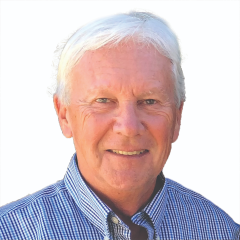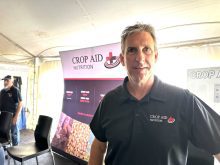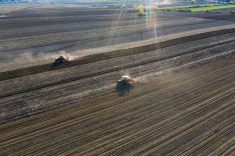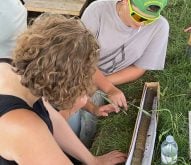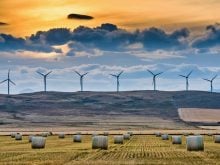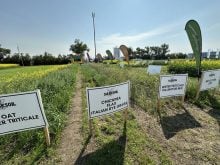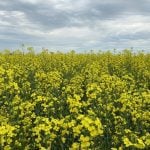We frequently hear discussion about soil quality and carbon sequestration. In this article I’d like to review some of the current thinking about soil organic matter and provide some thoughts about carbon sequestration.
To review, soil organic matter (SOM) is the small fraction of the soil that is mostly derived from plants and microbes. Most of Western Canada’s agricultural soils have between two and 12 per cent organic matter (OM). The table here shows typical organic matter levels for the various soil zones in Western Canada.
Read Also

Claas brings 1000 Series SP forage harvesters to Canada
In mid-August, Claas unveiled its new line of Jaguar forage harvesters at an event in Visalia, California, deep in the heart of that state’s dairy region.

The amount of organic matter that accumulated in native soils prior to breaking was result of several thousand years of plant, microbial and animal residue additions to the soil. At the same time, soil organic residues were constantly breaking down and in various stages of decomposition.
The amounts and types of SOM were strongly influenced by climatic factors, which in turn, dictated the types of native vegetation and growth that contributed to soil formation and OM additions to soil. For example, in the Brown soil zone, the warmer, drier climate meant short prairie grasses dominated the landscape and added relatively lower amounts of OM to soil — versus the Black soil zone, where a cooler, wetter climate meant fescue grasses dominated the landscape and added relatively higher amounts of OM to soil. Landscape and geographic location also played an important role in soil formation and OM additions and decomposition in soil on upper-, mid- and lower-slope positions.
After many years of soil formation and development, the amount of OM in soil reached a steady state or equilibrium. As a result, soils in drier regions of the Prairies in the Brown soil zone typically have two to three per cent organic matter, versus those in the moister regions of the Black soil zone with seven to 12 per cent OM.
Parton et al. (1983) suggested soil organic matter is made up of different components or fractions that can be grouped into four types:
• Plant residues: Typically break down in one to five years.
• Active: Organic matter that breaks down over five to 10 years.
• Slow: Organic matter that breaks down more slowly, over 10 to 100 years.
• Passive or stable: Organic matter that takes more that 100 years to break down and is commonly referred to as humus.
Soil microorganisms break down plant residues, active and slow fractions of soil organic matter. Humus is the passive or stable fraction of the soil organic matter that results from decomposed plant and microbial matter. Humus is dark and gives soil its brown to black colour; typically, the darker the soil colour, the higher the level of humus. Organic matter plays many important roles in soil and has many positive effects on soil properties.
Chemical benefits
• Soil organic matter is a storehouse for various plant nutrients.
• As soil microbes decompose organic matter, nutrients are released for plant uptake.
• Increases the soil’s ability to hold positively charged cations, which is referred to as cation exchange capacity (CEC).
• Increases the soil’s ability to resist pH change and increased soil buffer capacity.
Physical benefits
• Acts like a glue to bind soil inorganic particles together to improve soil structure.
• Improved soil structure, which reduces surface soil crusting issues.
• Improved soil structure also reduces wind and water erosion potential.
• Iimproved soil structure also aids in water infiltration and water penetration in soil.
• Acts as a sponge to increase soil water storage and helps to reduce water runoff.
Biological benefits
• Increased organic matter increases soil microbial biodiversity and activity.
• Humus gives soil a darker colour, which helps enhance absorption of the sun’s energy. Darker soils warm up more quickly in spring, which stimulate more rapid crop germination and emergence.
• Increased nutrient cycling in soil provides nutrients to other soil microbes and plants.
• In healthy topsoil, organic matter stores significant amounts of N, about half of all the phosphorus and much of the sulphur.

The graph you see here shows how cultivation affected the various SOM fractions after 100 years of cropping. The amounts of plant residue, active and slow fractions of OM significantly declined over 100 years of cultivation using the wheat-fallow system. Summerfallow, which left the soil idle for a growing season, resulted in increased stored soil moisture. Tillage aerated the summerfallowed soil, which stimulated microbial activity, resulting in accelerated SOM breakdown and nutrient release. In the fallow year, there are no plants growing to contribute to the SOM pool. As a result, many years of summerfallow had very negative effects on SOM, soil quality and soil fertility.
The graph shows how using a crop-fallow rotation resulted in the decline of soil carbon by up to 50 per cent in Prairie soils over 50 to 100 years. The plant residue, active and slow carbon fractions were most affected, but the passive fraction (more stable organic matter) was relatively unaffected by cultivation.

Over the past 30 to 40 years, many Prairie farmers have shifted to continuous cropping, more diverse crop rotations and direct seeding of crops and have used adequate rates of fertilization to achieve optimum crop production and increased SOM additions to soil. The interaction of these practices has been very positive to improve crop production. Also important, significant progress has been made to increase SOM, which in turn, has improved soil quality.
Direct seeding and continuous cropping have meant plant residues are returned to the soil every year and the rate of decay of organic matter is much slower with the elimination of summerfallow. By cropping the land every year, organic residues are produced every year to maintain and increase soil OM levels compared to the old wheat-fallow system.
Applying optimum rates of fertilizers ensures optimum crop yields and provides increased crop residue return to soil. Returning more residues to the soil can increase SOM content. Farmers who have been direct seeding and continuous cropping for over 30 years are likely reaching a new SOM equilibrium or steady state level.
Can we expect to see SOM levels increase to original native prairie levels? Not much, when only growing only annual crops. Native prairie grasses pumped considerably more carbon back into soil versus our annual crops. For most Prairie farmers who have been direct seeding, continuous cropping and fertilizing to optimum for that past 30 or more years, odds are most fields are now near a new steady state level of SOM. This means less opportunity to sequester and hold additional carbon in soils. Odds are the amount of carbon added to your soils each year will be similar to amounts mineralized from annual breakdown of SOM. There will be some fluctuation in SOM over years due to effects of droughts or wetter growing seasons.

Can additional soil organic carbon be sequestered when switching from annual crops to forage crops? The short answer: “Yes.” Forage crops pump more carbon into soil versus annual crops. When putting land back into a forage crop for a number of years, a significant increase can be expected. For example, our long-term crop rotation study at Bow Island, Alta. found a significant change in soil organic carbon over 24 years. The adequately-fertilized forage treatment had 61.8 Mg carbon/ha versus the adequately-fertilized continuously-cropped treatments at 45.5 Mg carbon/ha in the top 30 cm of soil after 24 years of cropping. Plots seeded to permanent grass had by far the greatest increase in soil organic carbon capture versus all other crop rotations after 24 years.
In summary, Prairie farmers have done an excellent job shifting to direct seeding, continuous cropping, using much more diverse crop rotations and fertilizing crops adequately, along with various other good agronomy practices. This has very positively improved soil organic matter levels and improved soil health across all the soil zones of the Prairies.

